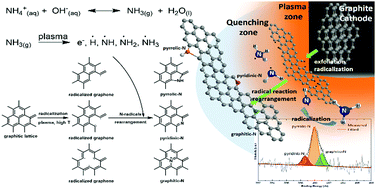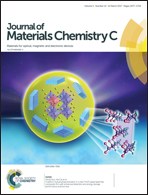Facile production of graphene nanosheets comprising nitrogen-doping through in situ cathodic plasma formation during electrochemical exfoliation†
Abstract
In this paper we report a facile and rapid electrochemical process, involving simultaneous in situ cathodic plasma exfoliation and nitrogen doping, for the production of nitrogen-doped graphene nanosheets. We used a novel electrochemical process to generate the plasma in situ: a graphite rod, serving as a cathode, generated in situ cathodic plasma when it came into slight contact with the electrolyte containing proper nitrogen species that can undergo dissociation with plasma and then form bonds with carbon such as ammonia molecules or nitrate/nitrite anions, resulting in induced exfoliation of the tip of the graphite rod into nitrogen-doped graphene nanosheets. X-ray photoelectron spectroscopy, elemental analysis, and energy-dispersive X-ray spectroscopy revealed that the concentration of nitrogen atoms doped in the graphene nanosheets varied from 0.6 to 0.81 at%. Transmission electron microscopy and scanning electron microscopy revealed that the as-produced nitrogen-doped graphene nanosheets comprised four layers of graphene and had a specific surface area of 164 m2 g−1. This process has potential for use in the industrial-scale mass production of nitrogen-doped graphene for various applications.


 Please wait while we load your content...
Please wait while we load your content...